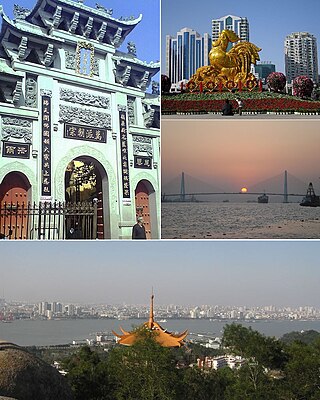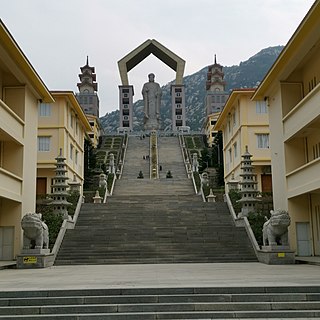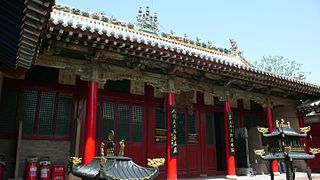
Shantou,alternately romanized as Swatow and sometimes known as Santow,is a prefecture-level city on the eastern coast of Guangdong,China,with a total population of 5,502,031 as of the 2020 census and an administrative area of 2,248.39 square kilometres (868.11 sq mi). However,its built-up area is much bigger with 12,543,024 inhabitants including Rongcheng and Jiedong districts,Jiexi county and Puning city in Jieyang plus all of Chaozhou city largely conurbated. This is de facto the 5th built-up area in mainland China between Hangzhou-Shaoxing,Xi'an-Xianyang and Tianjin.

Chenghai is a district of the city of Shantou,Guangdong Province,China.
Chaoshan or Teoswa is a cultural-linguistic region in the east of Guangdong,China. It is the origin of the Teochew Min (潮汕话). The region,also known as Chiushan in Cantonese,consists of the cities Chaozhou,Jieyang and Shantou. It differs linguistically from the rest of Guangdong province,which was historically dominated by Yue,Hakka,Haklau and Leizhou Min speakers.

Jieyang is a prefecture-level city in eastern Guangdong Province (Yuedong),People's Republic of China,part of the Chaoshan region whose people speak Chaoshan Min distinct from neighbouring Yue speakers. It is historically important as the hometown of many overseas Chinese in Southeast Asia. It borders Shantou to the east,Chaozhou to the northeast,Meizhou to the north,Shanwei to the west,and looks out to the South China Sea to the south.

Fengshun is a county in Meizhou City,in the east of Guangdong Province,southern China.

Nan'ao or Nanao,formerly romanized Namoa,is an island and county of the prefecture-level city of Shantou in Guangdong Province,China. The county spans a land area of 114.74 square kilometres (44.30 sq mi),and sea area of 4,600 square kilometres (1,800 sq mi). As of 2020,the county had a permanent population of approximately 64,429.

Liwan District is one of 11 urban districts of the prefecture-level city of Guangzhou,the capital of Guangdong province,China. The district is split into two parts by the Pearl River:Xiguan in the northeast and Fangcun in the southwest. The area has a prominent history,dating back to the Qin dynasty,and hosts a number of major historic sites. Liwan District spans an area of 62.4 square kilometres (24.1 sq mi),and as of the end of 2023,has a population of about 1,113,000.

Nan'an is a county-level city of southern Fujian Province,People's Republic of China. It is under the administration of Quanzhou City and as of 2023,had a total population of 1,663,542. More than 4,000,000 overseas Chinese trace their ancestry to Nan'an.

Xiuyu District is a district of the city of Putian,Fujian,People's Republic of China. The district executive,legislature and judiciary are in Hushi Town (笏石镇),together with the CPC and PSB branches.

Gangwei is a town in Longhai City,in Zhangzhou,Fujian,China (PRC).

Jinping District is the central business district and the seat of Shantou prefecture-level city in the Guangdong Province of Mainland China. The site the district stands on is the old city of Shantou established by Emperor Hongwu of the Ming Dynasty in AD 1369,with the name derived from Shashantou Fort built in the city 4 centuries later. The Jinping administrative district was established in 2003,and serves as a major hub for manufacturing,shipping and tourism. The district government is located at No. 50 Jinsha Middle Road.

Longhu District is a district of Shantou,Guangdong province,China. It is the birthplace of the famous Shantou Special Economic Zone.

Xi County or Xixian is a county in the southwest of Shanxi province,China. It is located in the northwest of the administrative area of the prefecture-level city of Linfen. The county spans an area of 1,413 square kilometres (546 sq mi),and according to the 2010 Chinese census,Xi County had a population of 103,617.

The Jiangong Islet is a tidal island in Jincheng Township,Kinmen County,Fujian Province,Republic of China (Taiwan).
Lingshan Temple is a Buddhist temple located in Chaoyang District,Shantou,Guangdong,China.
Events from the year 1683 in China.
Luci Island (Chinese:鸬鹚岛 / 鸬鹚屿;pinyin:LúcíDǎo/Yǔ/Xù;Wade–Giles:Lu2-tzʻŭ2 Tao3/Yü3/Hsü4;lit. 'cormorant island') (also Loutz Island (Lu-tzʻu,Lucih) and Lusi Island (Lusih,Lu-ssu) (Chinese:鷺鷥島;pinyin:LùsīDǎo;Wade–Giles:Lu4-ssŭ1 Tao3;lit. 'little egret island') is an uninhabited island southeast of the Asian mainland in Pinghai Town (平海镇),Xiuyu District,Putian,Fujian,People's Republic of China (PRC) and 9 nautical miles (17 km) north-northwest of Wuciou Township (Ockseu),Kinmen County (Quemoy),Republic of China (Taiwan) which can be seen from the island.

Dezhou Island,also known as Lu Yu,is an island in the waterway used by the Port of Shantou,0.5 km from Dahao Island. It has an area of 0.136 square kilometers and has a well-preserved lighthouse that was built in 1880.

Jiao,also known as Jiao-shang (郊商),Hang-jiao (行郊),and also known as Ding-shou (頂手) and Jiu-Ba-hang (九八行),was a commercial guild organization that spread throughout Taiwan during the Qing dynasty. The members of the organization were mostly ship merchants or merchants who settled in ports. In the middle of the Qing dynasty,the commercial function of Jiao was gradually declining due to the sedimentation
Queshi is a town-level sub-district under the jurisdiction of Haojiang District,Shantou City,Guangdong Province,China. According to the census in 2020,Queshe has a population of 47,119 and a total area of 38.50 km²,with the population density of 1,224/km².















